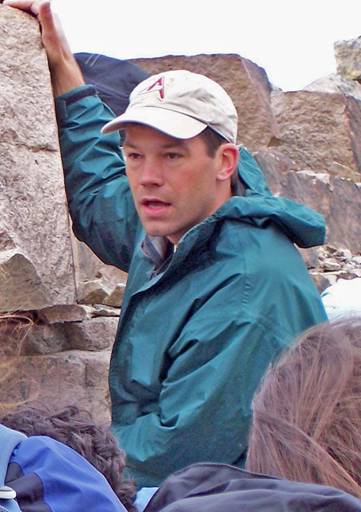James Madison University - Department of Geology & Environmental Science
Teaching Chaos and Complex Evolutionary Systems Theories at the Introductory Level
Model: Self Similarity
in a Bifurcation Diagram - Part 2 of 4 PartsStrategies and Rubrics for Teaching Chaos and Complex Systems Theories as Elaborating, Self-Organizing, and Fractionating Evolutionary Systems,
Fichter, Lynn S., Pyle, E.J., and Whitmeyer, S.J., 2010, Journal of Geoscience Education (in press)Description: Virtually every object in the natural world has some self similarity properties, and they are important in understanding the structure of systems that evolve. Technically these are fractals, which is a whole branch of mathematics, but the basic idea of self-similarity can be quickly grasped visually with the bifurcation diagram.
Presentation: We illustrate self-similarity with a series of zooms (Figure 3) deeper and deeper into the bifurcation diagram, revealing the existence of smaller and smaller bifurcation cascades. We generate the data with the Xnextbif.exe program, and create the diagrams with Grapher. The presentation is simple, and effective. There is a lab exercise with instructions on how to create these zooms.
We also do a zoom cascade into the Mandelbrot set using an old program we have available (its web availability comes and goes, but try "The Mandelbrot Set" Cerious Software, by Phillip Crews), but there are web sites that do the same thing. These take about 10 minutes, and in some classes are enough. Sometimes it is necessary to explore self-similarity as fractal geometry, and we discuss that below.
Anticipated Learning Outcome:
- 7. Self-similarity is patterns, within patterns, within patterns, so that you see complex detail at all scales of observation, all generated by an iterative process. We show examples of river drainage systems, plant branching patterns, zoom in on the Dow Jones on the stock market index, look at Earth temperature patterns during the past ice age, sea level curves, cladograms, and examples of fractally generated landscapes.
Figure 3 - Zooming in on the Bifurcation Diagram

 Lynn S. Fichter
Lynn S. Fichter
 Steve Baedke
Steve Baedke
 Eric Pyle
Eric Pyle
 Steve Whitmeyer
Steve Whitmeyer